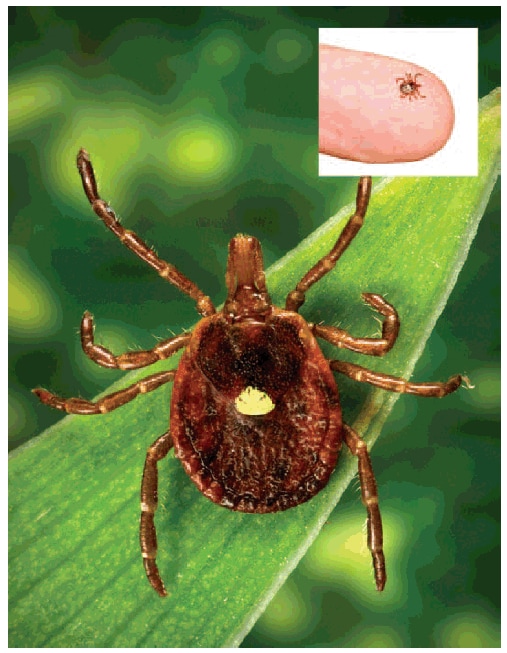Notes from the Field: Heartland Virus Disease — United States, 2012–2013
Daniel M. Pastula, MD1, George Turabelidze, MD2, Karen F. Yates, MS2, Timothy F. Jones, MD3, Amy J. Lambert, PhD4, Amanda J. Panella, MPH4, Olga I. Kosoy, MA4, Jason O. Velez4, Marc Fischer, MD4, J. Erin Staples, MD4 (Author affiliations at end of text)
Heartland virus is a newly identified phlebovirus that was first isolated from two northwestern Missouri farmers hospitalized with fever, leukopenia, and thrombocytopenia in 2009 (1). Based on the patients' clinical findings and their reported exposures, the virus was suspected to be transmitted by ticks. After this discovery, CDC worked with state and local partners to define the ecology and modes of transmission of Heartland virus, develop diagnostic assays, and identify additional cases to describe the epidemiology and clinical disease. From this work, it was learned that Heartland virus is found in the Lone Star tick (Amblyomma americanum) (Figure) (2). Six additional cases of Heartland virus disease were identified during 2012–2013; four of those patients were hospitalized, including one with comorbidities who died.
A confirmed case of Heartland virus disease was defined as a clinically compatible illness in a person with laboratory evidence of recent Heartland virus infection. A clinically compatible illness was defined as fever (≥100.4°F [≥38.0°C]), leukopenia (white blood cell count <4,500 cells/mm3; normal range = 4,500–12,000 cells/mm3), and thrombocytopenia (platelet count <150,000/mm3; normal range = 150,000–400,000/mm3) without a more likely clinical explanation. Evidence of recent Heartland virus infection included 1) detection of viral RNA by reverse transcriptase–polymerase chain reaction on blood or tissue or 2) a ≥4-fold rise in virus-specific plaque reduction neutralization antibody titers between acute and convalescent serum specimens.
During 2012–2013, six confirmed Heartland virus disease cases were identified; five patients were Missouri residents, and one was a Tennessee resident. All patients were men aged ≥50 years (median = 58 years; range = 50–80 years). Patients had symptom onset during May to September (three cases in May, one in July, and two in September). All of the patients had fever, thrombocytopenia, and leukopenia when first evaluated. Of the five patients whose acute symptoms were systematically recorded, all reported fatigue and anorexia, and four reported headache, nausea, myalgia, or arthralgia. Four of the patients were hospitalized. One patient with multiple comorbidities died. All of the patients reported spending several hours per day outside (e.g.,working, walking, doing yard work, hunting, or hiking), and five of the six patients reported tick bites in the 14 days preceding their illness onset.
No vaccine or medication is available to prevent or treat Heartland virus disease. Because the virus likely is transmitted through infected ticks or other arthropods, prevention depends on using insect repellents, wearing long sleeves and pants, avoiding bushy and wooded areas, and performing tick checks after spending time outdoors. Health-care providers should consider Heartland virus testing in patients who develop fever, leukopenia, and thrombocytopenia without a more likely explanation and who have tested negative for Ehrlichia and Anaplasma infection or have not responded to doxycycline therapy (3). Questions regarding Heartland virus testing should be directed to state health departments or to the CDC Arboviral Diseases Branch (telephone: 970-221-6400).
Acknowledgments
Scott M. Folk, MD, and staff at Heartland Regional Medical Center, St. Joseph; staff at St. Francis Hospital and Health Services, Maryville; staff at Mercy Hospital, Springfield; staff at St. Mary's Health Center, Jefferson City; staff at Truman Medical Center, Kansas City; staff at Children's Mercy Hospital and Clinics, Kansas City; C. Jon Hinkle, Jennifer Lloyd, MsPH, Missouri Department of Health and Senior Services. Staff at Vanderbilt University Medical Center, Nashville; Abelardo Moncayo, PhD, Tennessee Department of Health. Atis Muehlenbachs, MD, Dianna Blau, DVM, Sherif Zaki, MD, Infectious Disease Pathology Branch; William L. Nicholson, PhD, Rickettsial Zoonoses Branch; Robert S. Lanciotti, PhD, Janeen J. Laven, Stephanie J. Yendell, DVM, Roger S. Nasci, PhD, Harry M. Savage, PhD, Arboviral Diseases Branch, Division of Vector-Borne Diseases, National Center for Emerging and Zoonotic Infectious Diseases, CDC.
1EIS officer, CDC; 2Missouri Department of Health and Senior Services; 3Tennessee Department of Health; 4Arboviral Diseases Branch, National Center for Emerging and Zoonotic Diseases, CDC (Corresponding author: Daniel Pastula, dpastula@cdc.gov, 970-221-6400)
References
- McMullan LK, Folk SM, Kelly AJ, et al. A new phlebovirus associated with severe febrile illness in Missouri. N Engl J Med 2012;367:834–41.
- Savage HM, Godsey MS Jr, Lambert A, et al. First detection of heartland virus (Bunyaviridae: Phlebovirus) from field collected arthropods. Am J Trop Med Hyg 2013;89:445–52.
- CDC. Heartland virus. Atlanta, GA: US Department of Health and Human Services, CDC; 2014. Available at http://www.cdc.gov/ncezid/dvbd/heartland/index.html.
Use of trade names and commercial sources is for identification only and does not imply endorsement by the U.S. Department of
Health and Human Services.
References to non-CDC sites on the Internet are
provided as a service to MMWR readers and do not constitute or imply
endorsement of these organizations or their programs by CDC or the U.S.
Department of Health and Human Services. CDC is not responsible for the content
of pages found at these sites. URL addresses listed in MMWR were current as of
the date of publication.
All MMWR HTML versions of articles are electronic conversions from typeset documents.
This conversion might result in character translation or format errors in the HTML version.
Users are referred to the electronic PDF version (http://www.cdc.gov/mmwr)
and/or the original MMWR paper copy for printable versions of official text, figures, and tables.
An original paper copy of this issue can be obtained from the Superintendent of Documents, U.S.
Government Printing Office (GPO), Washington, DC 20402-9371;
telephone: (202) 512-1800. Contact GPO for current prices.
**Questions or messages regarding errors in formatting should be addressed to
mmwrq@cdc.gov.



